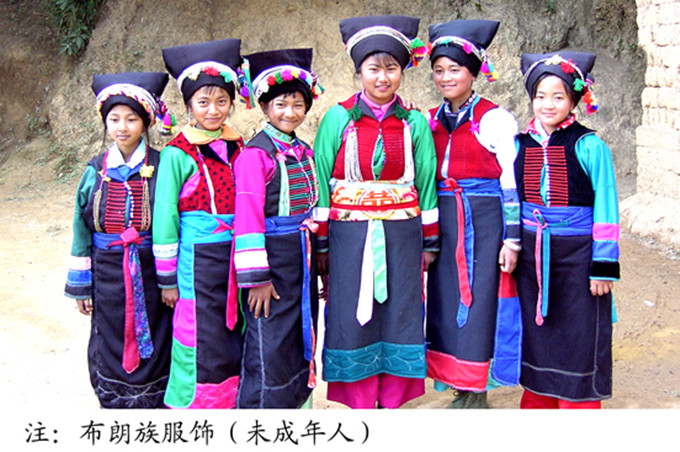

Bulang Ethnic Minority
Languages
People classified as Bulang in China speak various Palaungic languages, including Blang and U.
The Blang language belongs to the Palaungic branch of the Austroasiatic language family. Within the Palaungic branch, Blang belongs to the Waic subgroup, which also contains the languages of the Wa and Lawa peoples in addition to Blang. Some Blang also speak the Chinese language and Southwestern Tai languages in addition to Blang. Two systems of writing based on the Latin alphabet have been developed: 'Totham' in the Xishuangbanna and 'Tolek' from Dehong and Lincang.
History
Chinese ethnographers identify the Blang as descendants of an ancient tribe known as the "Pu" (濮), who lived in the Lancang river valley during ancient times. It is believed that these people were one branch of a number of peoples that were collectively known to the ancient Chinese as the Bǎipú (百濮, literally "Hundred Pu").
Culture
Traditionally, the Blang considered teeth blackened by chewing betel nuts a beauty characteristic.
The women usually dress in jackets with black skirts. The men had tattoos in the torso and the stomach. They dressed in wide black trousers and jackets buttoned to the front. Often they would wear turbans of either white or black fabric.
The houses of the Blang are made out of bamboo and usually consist of two floors. The first floor is designed as a warehouse for food and a stable for livestock animals, such as chickens, whereas the second is designed to house the family. The chimney is located in the center of the house.
The Blang are traditionally divided into small clans, with each clan owning its own land. Every Blang town has its own cemeteries, which are divided by clans. The deceased are buried, with the exception of those who perished due to unnatural causes. In this case they are cremated.
Religion
The Blang are traditionally associated with animism, ancestor worship, and Theravada Buddhism. Writing in 2011, James Miller described these overlapping traditions as follows, "The Blang, like many nationalities in southwest China are Theravada Buddhists, but their highly complex religious life is also informed by local beliefs and customs that relate to the traditional ecology, with special attention being paid to rice, water, bees, beeswax, and the various local spirits that are associated with them."[2] An overtly Christian missionary source (i.e., with observations reflecting attempts to convert the Bulang) describes them as "ardent followers of Theravada Buddhism", and offers as an estimate that 80% of the Bulang are "professing Buddhists", with a lower estimate of 35% being "practicing Buddhists".[3]


You will only receive emails that you permitted upon submission and your email address will never be shared with any third parties without your express permission.
